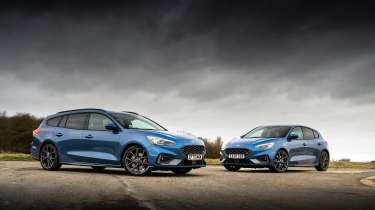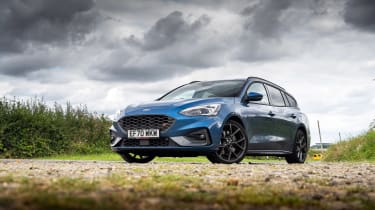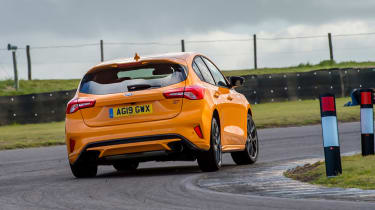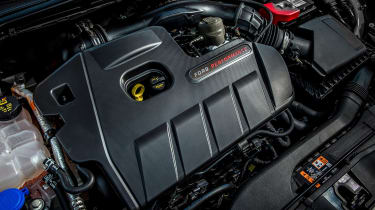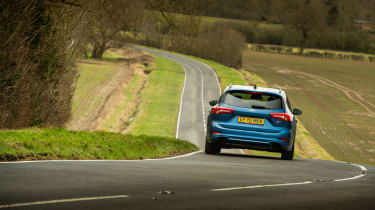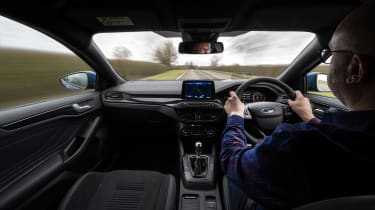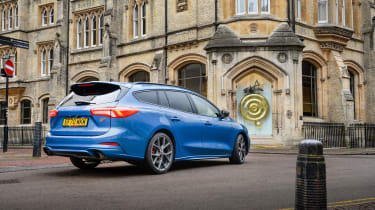Used Ford Focus ST (Mk4, 2019 to date) review and buyer’s guide
The Focus ST is quick and entertaining, and while not a class leader it’s a great hot hatch all-rounder
With no Focus RS to keep us entertained with this generation of Ford’s mid-range hatch it’s left to the ST to fly the flag for the fast Ford brigade, and the ST makes a pretty good fist of it. Perhaps it’s best to view the ST as a great all-rounder rather than a scalpel-sharp machine, and while it won’t trouble a Honda Civic Type R or a Hyundai i30 N for the ultimate in tactility it is an entertaining steer and offers a blend of attributes that makes it worthy of consideration.
It has a punchy, torque-rich engine and offers good performance, along with a surprisingly practical interior and decent levels of equipment. As an everyday car that can still offer a rewarding drive it’s not a bad choice at all.
History
It’s not that long ago that just about everyone seemed to drive a hatch of some description, and while the market might have taken a turn for the worse with a plethora of SUVs and crossovers the performance hatch is just about clinging on as an affordable yet practical alternative to more dedicated performance cars. Ever since its launch Ford’s Focus has almost always had a chassis that’s been crying out for more power, and while the bonkers Focus RS is no longer part of the line-up the ST is only marginally less talented.
More reviews
Group tests
In-depth reviews
Reviews
The latest generation of ST is the fourth incarnation of the model and made its market debut in early 2019 with a choice of two engines, a 2.3-litre turbocharged petrol or a 2-litre diesel, and two body styles – five-door hatch or five-door estate. Both engines are teamed with a six-speed manual gearbox and the petrol receives an eLSD while the diesel makes do with ‘Torque Vectoring Control’ which uses the car’s brakes to impersonate the effect of an LSD. A seven-speed auto was introduced in 2020 but could only be ordered with the EcoBoost petrol engine.
In 2021 an Edition model was launched, exclusively for the five-door petrol hatch, that was aimed at further enhancing the ST’s precision and agility. Easily spotted by its Azura Blue paintwork, black roof and lightweight alloy wheels the main difference between this and the standard ST is the adoption of a Ford Performance-tuned KW coilover suspension set-up. Unlike the electronic dampers on the standard ST the Edition’s set-up is manually adjustable, with 12 bounce settings and 16 for the rebound. The spring rates are increased by 50 per cent over the regular ST.
The ST received a facelift in the latter part of 2021 and at the same time the diesel engine option was dropped from both the hatch and estate, reflecting the general drop-off in diesel sales. Changes included a revised front bumper and grille treatment along with LED headlights, while Mean Green paintwork was added to the options list and 19-inch alloys replaced the 18s as standard kit. Inside, the Recaro seats were dropped in favour of a new set of Ford-designed 14-way adjustable items, while the new-look dash included a 13.2-inch touchscreen running Ford’s latest Synch 4 software. Less appealing was a £3000 price hike over the outgoing model.
Prices, Specs and Rivals
One thing that the ST had in its favour in its three previous incarnations was that it was attractively priced when compared to the competition, but with a £30k price when new the current Focus ST was priced right in the heart of hot hatch territory and was up against some stiff opposition. And with the 2021 price hike the ST was pitched into a very competitive sector.
One of the best is the Honda Civic Type R – one of our class favourites – and while the ST might not have the polarising looks of the Honda it’s not as dynamically exciting either. Other rivals include the latest Volkswagen Golf GTI, now in Mk8 guise, which is a better all-rounder, and the Hyundai i30 N which has a more engaging powertrain and an excellent chassis.
The ST is relatively well equipped, with the later cars coming with 19-inch alloys, LED front and rear lights, Ford Performance heated seats and steering wheel, and Ford’s Sync 4 navigation system.
Engine, gearbox and technical highlights
Up until the ST’s facelift in late 2021 there were two engine choices – petrol or diesel – and both were available in the hatch and the estate. The pick of the pair is the 2.3-litre four-cylinder EcoBoost that can be mated with either the standard six-speed manual or optional (£450) seven-speed automatic. It’s quite a sizeable unit for the class these days, and while it develops 276bhp at 5500rpm that doesn’t equate to class-leading with the Civic Type R beating it by 40bhp, although the ST does offer more power than the Mk8 VW Golf GTI.
The larger capacity than the 2-litre class norm does mean that it’s pretty torquey at 310lb ft, which beats the Honda by 15lb ft and offers a considerable advantage over the Golf’s 273lb ft. Whilst not as inspiring as the older ST’s five-pot, the EcoBoost doesn’t sound too bad, either, giving out a nice induction roar, and there’s decent throttle response, especially in Sport mode.
The second engine option is a 2-litre diesel with 187bhp and 295lb ft of torque and it does a reasonable job of shifting the Focus around, but with a fairly obvious lack of verve when compared to the petrol. The petrol receives an electronic LSD to send power to the driven wheel with the most grip, while the diesel uses Torque Vectoring Control to brake a spinning wheel. There are various driving modes, too – Slippery, Normal and Sport – and if you option the Performance Pack there’s an additional Track mode.
Performance and 0-60 time
Given its larger than average engine size you might be expecting great things from the ST, and for the most part its on-paper stats show it in a good light. The petrol model has a 0-62mph time of 5.7sec, although for the facelifted model this is now listed as 5.8sec despite having the same power and torque as the pre-facelift! Both the manual and auto record the same time and both have a top speed of 155mph. The Golf GTI has less power and is slightly slower at 6.4sec, while the Civic Type R and Hyundai i30 N post 5.8sec and 5.9sec times respectively.
The petrol model does put its power down pretty well, though, and if you are equipped with the Performance Pack there’s a launch control function that allows you to make the best of the 276bhp. Mid-range punch is where the Focus ST is at its best, feeling particularly muscular once the turbo’s fully spooled up, but it isn’t quite so keen to chase the red line as some of its rivals.
The diesel is a 2-litre and isn’t anywhere near as punchy as the petrol model but offers a respectable 0-62mph time of 7.6sec and a top speed of 137mph, but most buyers will be far more concerned about its economy potential which nudges 60mpg if driven sensibly.
Ride and handling
The third generation of Focus ST wasn’t the best of fast Fords, but its deficiencies – poor traction and slightly underwhelming engine – have certainly been attended to for the Mk4. Its chassis is far better resolved than the Mk3’s and the eLSD does a good job of delivering power to the wheel that needs it the most. Overall it feels agile and has decent body control, while the direct steering assists in getting the most from the chassis. That steering is very quick, though – perhaps too direct for some at just two turns from lock-to-lock – so do try before you buy.
As standard the ST comes with adaptive dampers which, while on the firm side, still do a good job of isolating you from the worst road surfaces but never let you forget that this is still a fast Ford.
MPG and running costs
Buying a performance hatch is never going to be the most frugal of decisions, but the ST shouldn’t break the bank. Vital stats for the EcoBoost petrol are an average economy of 35.8mpg (irrespective of gearbox or body style) and CO2 emissions of 179g/km (183g/km for post-facelift models), while the diesel’s figures are 58.8mpg and 125g/km.
Annual VED should be the standard flat rate (now £165/year) for both the petrol and diesel models, but in theory it’s just possible that an original owner could have gone mad with the options list and sent the cost of an ST to the over £40k mark which would attract a VED rate of £520 for years two to six. It’s unlikely, but worth checking.
Ford servicing shouldn’t break the bank and there are service plans available to spread the cost. Ford’s warranty isn’t as generous as some, covering just three years or 60,000 miles (especially compared to Hyundai’s five-year, unlimited mileage warranty).
Interior and tech
The interior of the Mk4 ST is a step up from the previous generation, and while the quality of materials and fit and finish might not quite be up to Volkswagen levels it’s still a pleasant place to sit and you shouldn’t feel desperately short-changed. The driving position is good, with plenty of adjustment for the seat and steering wheel, although the Recaros in pre-facelift cars are a little narrow for the fuller-figured driver and the flat-bottomed wheel is a little fat. Post-facelift cars have Ford-designed sports seats that come with the approval of the German Aktion Gesunder Rücken – the Campaign for Healthier Backs.
Earlier cars will feature Ford’s Sync 3 infotainment – better than what went before, but still not class leading – which can be a little laggy and slow at times, but facelift cars come with a bigger screen backed up by Sync 4 technology, which is a much better bet.
The ST is pretty roomy inside and entry and egress is helped by its five-door-only format. The boot is just about class-leading and more or less on a par with those of a Golf or Megane RS.
Design
Perhaps the way the ST looks will depend most on whether you prefer your hot hatch to be an extrovert or not. It’s not blessed, or cursed depending on your viewpoint, with a particularly aggressive bodykit, and in milder colours it could easily be mistaken for a lesser-engined Focus. Spec it in one of the wilder colours, though, and the detailing stands out a little bit better. It’s not as extroverted as a Civic Type R or Hyundai i30 N, and not quite as premium-looking as a Golf GTI, but if you’re happy with subtle and stylish the ST ticks those boxes pretty well.
Buyer’s guide
Prices
There are plenty of hatchback examples to choose from in the used market but prices have yet to drop significantly, perhaps not surprising given the ST is still a relatively new machine. The petrol ST proved to be more popular than the diesel so there are a significantly higher number of EcoBoost STs on the market, and the good news for keen drivers is that they’re almost exclusively manuals, the auto not proving to be a huge hit with buyers. Obviously the news isn’t so good if you’re after an auto as they’re few and far between.
However, the ST estate sold in relatively small numbers and is considerably rarer than the hatch. The sales split would appear to be about 50:50 in terms of petrol and diesel sales. Fords don’t generally hold their value that well so expect prices to tumble a little as the cars get older.
Range, specifications and options
The ST range is effectively a choice between petrol and diesel for both the hatch and estate, or if you’re looking at very late 2021 onwards cars then there’s no longer the option of a diesel. All models feature a six-speed manual as the standard gearbox, although a seven-speed auto can be optioned on the EcoBoost petrol.
All STs come relatively well equipped, with air con, part-leather Recaro seats, navigation, Bluetooth, DAB, Apple CarPlay and Android Auto. Adaptive dampers are standard, while petrol models also receive an electronic LSD to help deploy that 276bhp. The most desirable option is the Performance Pack which adds a launch control function and a further mode, Track, that sharpens responses still further. The ultimate model is the Edition which ditches the adaptive dampers for a KW coilover set-up – you lose the ability to adjust them at a touch of a button, though.
Problems and checks
The Focus ST is still a relatively new car so its long-term reliability is hard to judge, but initial reports from owners do seem to indicate that build quality isn’t as good as expected from a car that costs over £30k. Numerous trim rattles from the doors and dash pod areas seem to be a common complaint. As a brand Ford doesn’t score particularly well or particularly badly in reliability surveys, generally occupying the middle ground. If you plan to keep an ST for several years you might want to consider extending Ford’s somewhat miserly warranty to cover any potential problems.
Most STs will have been driven relatively hard during their lives so check for stone chips or any crash damage. Check for consistent panel gaps and a good paint match between panels. Examine alloys for pothole or kerb damage and check tyres for evenness of wear and that they’re a quality brand.
Recalls
This generation of Ford Focus has been subject to several recalls, ranging from a software problem affecting the Ecall system to loose oil filler caps. Check for any outstanding recalls either on the Ford website or by giving a car’s chassis number to a Ford dealer to ensure any outstanding work has been completed.
